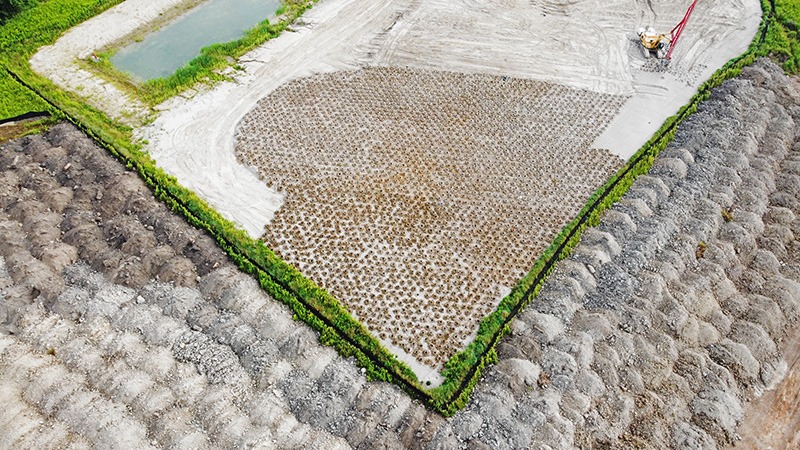
With growing concern over the future of the planet, Menard Canada has decided to challenge itself and set up a roadmap to drastically minimize its carbon footprint over the coming years in hopes of bringing others in the geotechnical field into this global fight against climate change. As a result, the company has been integrating environmental sustainability into everything it does and is continually investing in advanced solutions to improve environmental outcomes.
Menard Canada has extensive experience in regional geotechnical conditions, a huge benefit in an age where excess soils and the environmental impact of construction and engineering are taking centre stage. The company has consistently worked to raise the bar on sustainability in all its operations, always safeguarding and respecting the environment in which it operates. By providing quality ground improvement solutions to ensure an effectively minimized environmental impact, Menard Canada has reaped the rewards of supporting the environment and is consistently working towards using environmental best practices in all that it does.

A culture of sustainability
Menard Canada takes a 360-degree approach to sustainability to instill awareness and to encourage positive change in all its on-site and off-site employees. The primary and ongoing initiative is creating an authentic culture of sustainability with a focus on the environment.
The motto, “Less is More Menard,” shows how the company works. To Menard Canada, the concept is simple and translates to using fewer resources and creating less waste. These principles are deeply engrained in all the company does. Priding itself on a legacy of pioneering innovation and simplicity has helped Menard Canada become known as one of Canada’s environmentally conscious geotechnical contractors. The company identifies environmental protection as one of its most important guiding principles and a key component of everyday good business practices and operations.
So, how is a culture of sustainability that becomes engrained within each employee created, both professionally and personally? Well, it is a combination of things. A sustainable work environment requires ongoing and regular education sessions for all employees, along with periodic communications on how they can contribute to sustainability in and out of the office. It’s all about continuously educating employees where the carbon footprint of their work is and what can be done to lower this impact. As a design and build contractor, Menard Canada teams strive to make any project more sustainable.
In addition to becoming educated, employees are encouraged to speak up about any ideas that will impact the company’s carbon footprint. These workshops bring design teams, operations teams, administration teams and accounting teams together to collaborate on more prudent ways to perform their daily tasks. In addition, Menard Canada has specific committees set up to implement and track their sustainability action plan. Menard Canada takes sustainability a step further than their employees; it instills this same concept of sustainability into its project partners, suppliers and clients, and brings the sustainability topic into project discussions. It is the collective action of the industry that will have the most significant impact on what the planet will look like for future generations.
Sustainability in action
Every company should have an action plan to back up its ideas of being more sustainable; otherwise, the topic can easily end up on the back burner and be forgotten. It also needs to be reinforced with a measurable action plan that makes sense for positive and ongoing improvements. Menard Canada aims to:
- Reduce its direct emissions by 40 per cent by 2030 (against its 2018 baseline). These emissions are related to company cars, worksite machines, heavy vehicles and fixed building operations (yards and offices).
- Reduce its indirect emissions by 20 per cent by 2030, compared to 2019. These emissions come from purchased materials for the jobsite (concrete and aggregates), the impact of sub-contractors on site and even business trips by flight or train.
These targets challenged the company to track relevant key performance indicators on a regular basis so that every employee is committed to the environmental plan in all they do.
Menard Canada’s green ambition plan brought practical actions, including:
- Employee incentives on energy-efficient or electric vehicles
- Implementation of advanced fuel tracking systems on all equipment
- Optimized material quantities and characteristics based on local availability
- Use of low-carbon concrete
- Incorporating the calculation of carbon dioxide equivalent for any project being priced
What about ground improvement?
Menard Canada’s approach to ground improvement mirrors the principles deeply embedded in the company’s overall culture, using fewer resources and creating less waste while still improving the soil in challenging conditions.
It’s all about continuously educating employees on the benefits of sustainability, not just for the business, but also for future generations.
Ground improvement has proven to be the most cost-effective and reliable approach for densifying and reinforcing soils. It has also proved to be an environmentally positive approach for treating and improving poor soil sites.
Their ground improvement systems are designed to be environmentally sound alternatives to deep foundations and other approaches like dig and replace methods that, besides having a major carbon footprint, regard soil as waste, rather than a valuable asset. Instead, Menard Canada’s ground improvement offers low-impact, highly effective techniques for lessening the environmental effects of development and construction-related activities, all while supporting, reinforcing and strengthening site soils for various structures.
All of their ground improvement solutions are environmentally sound approaches that avoid the creation of excess soils or other types of spoils, resulting in a significantly lower carbon footprint. In simplified terms, Menard Canada’s ground improvement systems benefit the environment by:
- Using zero-spoil approaches: Avoiding excess soils
- Lowering their carbon footprint: Using low-carbon concrete
- Treating soils in-situ: Lowering environmental disturbance
Calculating embedded carbon
As cities across Canada set total embodied carbon targets on construction projects, architects, structural engineers and contractors must innovate and find alternate construction solutions with a lower carbon footprint.
The economic advantages of ground improvement solutions can also be found on the carbon footprint side. To evaluate ground improvement’s carbon impact and reduce it, Menard has conducted extensive work on its construction projects in Canada to obtain a reliable methodology to calculate the ton equivalent CO2 generated by ground improvement techniques.
Menard Canada conducted several case studies to assess the impact of specific ground improvement techniques, when compared to a more traditional approach. The case studies included:
- Ground improvement of an uncontrolled fill using dynamic compaction: divided by eight, the carbon footprint of the works compared to the initial dig and replace option planned for this project.
- The installation of a cement bentonite cut-off wall compared to a soil-bentonite wall: brought significant carbon savings for the project. The impact could be even lower with the use of slag and fly ash mixes or recycled materials from the jobsite.
In these two applications, the carbon footprint reduction resulted from using more “carbon-efficient” construction processes.
Value engineering by Menard Canada
Value engineering systematically analyzes various components and material functions to lower the cost of goods, products and services with a tolerable loss of performance or functionality. Ground improvement has led the way in value engineering by simplifying complex foundation projects, lowering their carbon emissions while still cutting the bottom-line costs for their clients and being an environmentally sensitive approach for almost any foundation project.
By choosing ground improvement, companies are effectively taking a stance on what they deem to be an environmentally responsible approach to geotechnical projects, one that can and should be adopted across all construction industries to make a united and positive impact on environmental sustainability.
To learn more about ground improvement, go to www.menardcanada.ca.